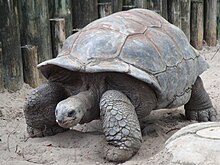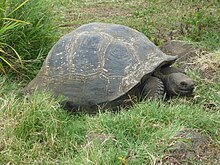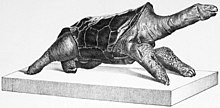Giant tortoise

Giant tortoises are any of several species of various large land tortoises, which include a number of extinct species,[1] as well as two extant species with multiple subspecies formerly common on the islands of the western Indian Ocean and on the Galápagos Islands.[2]

History
As of February 2024, two different species of giant tortoise are found on two remote groups of tropical islands: Aldabra Atoll and Fregate Island in the Seychelles and the Galápagos Islands in Ecuador. These tortoises can weigh as much as 417 kg (919 lb) and can grow to be 1.3 m (4 ft 3 in) long. Giant tortoises originally made their way to islands from the mainland via oceanic dispersal. Tortoises are aided in such dispersal by their ability to float with their heads up and to survive for up to six months without food or fresh water.[3]
Giant tortoises were once all placed in a single genus (often referred to as Testudo or Geochelone), but more recent studies have shown that giant tortoises represent several distinct lineages that are not closely related to one another.
Giant tortoises are classified into several distinct genera, including Aldabrachelys, Centrochelys (in part, often excluding the extant African spurred tortoise (Centrochelys sulcata)), Chelonoidis (in part), †Cylindraspis (extinct c. 1840), †Hesperotestudo (extinct c. 9,000 years Before Present), †Megalochelys, †Solitudo, and †Titanochelon. Both Megalochelys and Titanochelon reached sizes substantially greater than modern giant tortoises, with up to 2.4 m (7 ft 10 in) and 2 m (6 ft 7 in) shell lengths respectively.
The phenomenon of animal species evolving in cache to unusually large size on islands (in comparison to continental relatives) is known as
Giant tortoises are notably absent from
Although often considered examples of
Giant tortoises (†
Today, only one of the subspecies of the Indian Ocean survives in the wild; the
Life expectancy
Giant tortoises are among the world's longest-living animals, with an average lifespan of 100 years or more.
On 23 March 2006, an
List of insular species
Taxonomy of extant and extinct insular giant tortoise species follows Rhodin et al. (2021),[17] unless otherwise noted.
Aldabrachelys
| Archipelago | Island | Species |
|---|---|---|
| Seychelles | Granitic Seychelles[a][b] |
|
| Aldabra Atoll | Aldabra giant tortoise (A. gigantea gigantea) | |
| Cosmoledo | †Aldabrachelys sp.[19] | |
| Denis Island | ||
| Assumption Island | ||
| Astove Atoll | ||
| Glorioso Islands | Glorioso Islands | †Aldabrachelys sp.[19] |
| Comoro Islands | Comoro Islands | †Aldabrachelys sp.[19] |
| Madagascar | Madagascar |
|
Chelonoidis
| Archipelago | Island | Species |
|---|---|---|
| Galápagos Islands | San Cristóbal | San Cristobal giant tortoise (C. niger chathamensis) |
| Isabela |
| |
| Santiago | Santiago Island giant tortoise (C. niger darwini) | |
| Santa Cruz |
| |
| Ferdandina | Fernandina Island Galápagos tortoise (C. niger phantastica) | |
| Pinta | †Pinta Island tortoise (C. niger abingdonii) | |
| Floreana | † Floreana Island tortoise (C. niger niger)
| |
| Pinzón | Pinzón Island giant tortoise (C. niger duncanensis) | |
| Española | Hood Island giant tortoise (C. niger hoodensis) | |
| Santa Fe | †Santa Fe Island tortoise (C. niger ssp.) | |
| Lucayan Archipelago | Andros | †Abaco tortoise (C. alburyorum alburyorum) |
| Nassau | ||
| Mayaguana | ||
| Crooked Island | ||
| Gran Abaco | ||
| Grand Turk | †Turks tortoise (C. alburyorum keegani) | |
| Middle Caicos | †Caicos tortoise (C. alburyorum sementis) | |
| Greater Antilles | Cuba | †Cuban giant tortoise (C. cubensis) |
| Hispaniola |
| |
| Mona | †Mona tortoise (C. monensis) | |
| Navassa | †Chelonoidis sp. | |
| Lesser Antilles | Sombrero | †Sombrero tortoise (C. sombrerensis)[21] |
| Curaçao | †Chelonoidis sp. |
Other genera
| Archipelago | Island | Species |
|---|---|---|
| Mascarene Islands | Réunion | †Réunion giant tortoise (Cylindraspis indica) |
| Rodrigues |
| |
| Mauritius |
| |
| Malta | Malta | †Centrochelys robusta[c] |
Aldabra giant tortoise
The Aldabra giant tortoise (Aldabrachelys gigantea) lives on the remote Aldabra Atoll, one of the Seychelles group of islands in the Indian Ocean It is the only living species in the genus Aldabrachelys. Two other species in the genus, Aldabrachelys abrupta, and Aldabrachelys grandidieri were formerly endemic to Madagascar, but became extinct after the arrival of people.
Distribution and habitat

Aldabra giant tortoises have large dome-shaped shells in order to protect their delicate bodies that lie beneath their shells. They also have long necks in order to eat leaves from the higher branches of trees. The males, although not much bigger than the females, weigh nearly 100 kg (220 lbs) more. They move slowly and have small, thick legs and round, almost flat feet that assist them in walking on sand.
The Aldabra giant tortoise mainly inhabits
Species and subspecies
Galápagos giant tortoise
The closest living relative of the

These buccaneers stocked giant tortoises not only because of their meat but because of these animals' ability to survive for six months to one year without food or water.[citation needed] Once buccaneers, whalers and fur sealers discovered that they could have fresh meat for their long voyages by storing live giant tortoises in the holds of their ships, massive exploitation of the species began. Tortoises were also exploited for their oil,[citation needed] which was used to light the lamps of Quito.
Two centuries of exploitation resulted in the loss of between 100,000 and 200,000 tortoises. Three subspecies have been extinct since the 19th century, and a fourth subspecies lost its last member,
Distribution and habitat
Galápagos tortoises are mainly
They spend an average of 16 hours a day resting. Their activity level is driven by ambient temperature and food availability. In the cool season, they are active at midday, sleeping in during the morning and afternoon. In the hot season, their active period is early morning and late afternoon, while midday finds them resting and trying to keep cool under the shade of a bush or half-submerged in muddy wallows.[citation needed]
Life cycle
Tortoises breed primarily during the hot season from January to May; however, tortoises can be seen mating any month of the year. During the cool season (June to November), female tortoises migrate to
The eggs incubate from 110 to 175 days (incubation periods depend on the month the clutch was produced, with eggs laid early in the cool season requiring longer incubation periods than eggs laid at the end of the cool season, when the majority of their incubation will occur at the start of the hot season). After hatching, the young hatchlings remain in the nest for a few weeks before emerging out a small hole adjacent to the nest cap. Usually, the temperature of the nest influences on the sex of the hatchling. Warm temperatures would yield more females, while colder temperatures would yield more males.[citation needed]
Subspecies
Mascarenes giant tortoises

The
They belonged to a far more ancient lineage than the two extant giant tortoises, having diverged from all other tortoises during the Eocene, with divergence between the individual species far greater than that between the insular subspecies of the extant tortoises. The divergences between some Cylindraspis species are thought to be even older than the geologic history of the modern Mascarenes themselves, indicating that Cylindraspis originally inhabited several now-submerged island chains of the Mascarene Plateau before colonizing the modern Mascarene islands following their formation.[17][27]
Around the 16th century, with human arrival and the subsequent introduction of domestic animals, particularly
On Mauritius, the giant tortoise disappeared from the main island by the end of the 17th century and the very last tortoises survived until the 1730s on the
Today, the only remains from these five species are a number of
Species
Footnotes
- ^ Cerf Island, Cousine Island, Frégate Island, Mahé, Praslin, Round Island, and Silhouette Island.
- ^ Exact geographic range of these subspecies prior to human arrival is unknown, especially as tortoises have been moved between islands, but populations of Aldabrachelys are known to have existed at one time on all of these islands.[18]
- ^ Often treated as Centrochelys but Pérez-García et al. (2017) suggests it could pertain to Titanochelon.[9]
See also
References
- ^ ISBN 9780128175552.)
{{cite book}}: CS1 maint: multiple names: authors list (link - ^ "Definition of giant tortoise". Merriam-Webster.
- ^ PMID 16678445.
- ISBN 978-0965354004.
- PMID 21270022.
- ^ . Retrieved 6 May 2019.
- ^ ISSN 1514-5158.
- S2CID 83799914.
- ^ hdl:10261/277114.
- ISBN 978-90-481-9961-7.
- PMID 20713711.
- ^ Keim B (17 August 2010). "Extinct, King Koopa-Style Giant Turtle Found on Pacific Island". Wired. (Popular presentation of some material from the PNAS article)
- ^ Jones Jr RC. "Matter of Time". Miami Magazine Online. Archived from the original on 3 January 2003. Retrieved 26 December 2017.
- ^ "Galápagos Tortoise: National Geographic". 10 September 2010. Archived from the original on 7 February 2010. Retrieved 26 December 2017.
- ^ "Harriet the Tortoise dies at 175". 23 June 2006. Retrieved 21 February 2021.
- ^ a b A-Z-Animals.com. "Aldabra Giant Tortoise". Retrieved 26 December 2017.
- ^ a b "Tortoise and Freshwater Turtle Specialist Group". Retrieved 24 March 2022.
- ^ Tortoise and Freshwater Turtle Specialist Group (2011). "Conservation Biology of Freshwater Turtles and Tortoises". International Union for Conservation of Nature (IUCN).
- ^ .
- )
- doi:10.1111/j.1600-0587.2010.06305.x. Archived from the original(PDF) on 24 July 2011. Retrieved 26 February 2011.
- ^ "Habitat of Dipsochelys (Aldabra giant tortoise)". nhm.ac.uk. National History Museum. Retrieved 31 December 2014.
- ^ "Floreana History – Pre 1900s". Diving The Galapagos blog. 28 July 2009. Retrieved 26 February 2011.
- ^ a b "Giant Tortoises". Galapagos Conservancy, Inc.
- ^ Langlois J (22 February 2019). "How an 'extinct' tortoise was rediscovered after a century's absence". Animals. Archived from the original on 23 February 2019. Retrieved 27 September 2019.
- ISBN 978-0-00-724818-6.
- PMID 31767921.
- ^ Hume JP (September 2010). "Mascarene Giant Tortoises – Naturalis Biodiversity Center". naturalis.nl. Naturalis. Archived from the original on 13 December 2014. Retrieved 31 December 2014.
- ^ "Recently Extinct Animals – Species Info – Saddle-backed Rodrigues Giant Tortoise". The Extinction Website. PeterMaas. August 2009. Archived from the original on 3 March 2016. Retrieved 31 December 2014.
External links
- A giant Aldabra tortoise
- Galapagos Giant Tortoise Archived 15 October 2015 at the Wayback Machine
